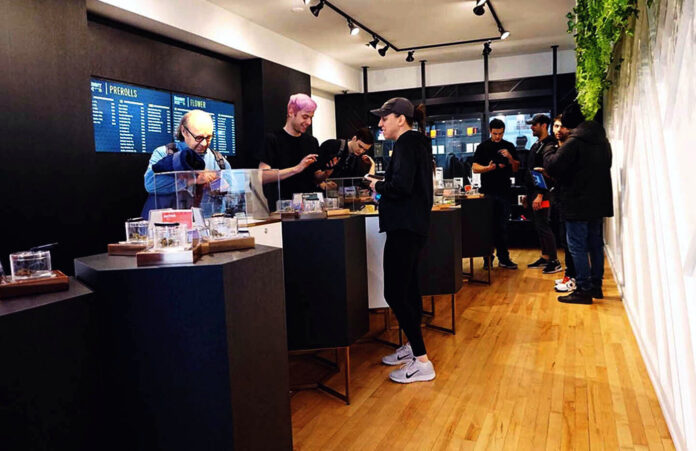To provide customers with a dynamic experience at every possible touchpoint, retail cannabis brands could take great examples from the quick-service restaurant (QSR) model — more specifically, the “smart menu” experience mastered in the fast food space. Through a smart menu experience, QSRs offer their customers a curated, simple, easy-to-understand list of in-store offerings. In replicating this approach, cannabis retailers can help customers across all visitor profiles make educated decisions before reaching a budtender. This helpful add-on serves to enhance the customer experience, increase operational efficiencies, and improve average per-cart orders.
Data indicates by incorporating technology, the QSR model has delivered excellent experiences and built customer loyalty; however, all too often cannabis retailers are unsure whether they’ll receive adequate return on investment (ROI). Reluctant brands usually come around once they see the QSR model in action at competing dispensaries.
Until that day comes for your brand, let’s explore why QSR, through the smart menu approach, saves time, enhances the customer experience, and drives increased revenue.
Enhance the customer experience with a smart menu
Can cannabis learn from a clown and cheeseburgers? Without a doubt.
The parallels are numerous. So, let’s start with the bottom-line benefit: On average, dispensaries see an average increase in traffic and cart totals of 4 percent to 18 percent when using the right QSR and smart signage strategy.
Think about your favorite shopping experiences, be they for burgers, fashion, or groceries. No matter the industry, high-quality experiences almost always drive foot traffic and revenue. With a QSR-led approach, dispensary experiences have the potential to be enhanced for every customer, whether in-store or not, because customers become better informed about products. QSR tends to develop more consumer confidence about purchases, which should streamline the buying process. And for the products about which consumers are yet unaware, a QSR smart menu approach can be a helpful guide, educating customers about items that might pique their interest.
That leads me back to Ronald McDonald.
McDonald’s is quite possibly the gold standard in QSR, especially the in-store experience. While the products aren’t similar, cannabis companies can learn from fast-food giants. The rules apply regardless of sector: A store’s menu performs best when it informs customers, building their purchasing confidence along the way.
The proper QSR helps customers learn about product offerings through a modern, curated, easy-to-understand menu. Brands can benefit from replicating the experience across mobile, online, and storefront. With a multiplatform approach, consumers have a seamless brand experience coupled with fast, efficient, and helpful shopping at every touchpoint.
In fast food, this approach allows customers to know they want a specific product before reaching the ordering counter. The same theory helps cannabis consumers know they want gummies and a gram of fresh hybrid flower. When the customer reaches the counter, the budtender can suggest a pre-roll or other item that’ll help improve their shopping experience. Think of it as the “Do you want fries with that?” approach for dispensaries.
Once in the system, a QSR tech stack can help turn clients into return business. This is achieved through artificial intelligence that learns and suggests items based on past purchases. The approach is a surefire way to educate customers and the company further while making the buying process more efficient.
Now, let’s explore the bottom-line benefits a bit more in-depth.
Smart menus influence and increase sales
Are you starting to see how the concept that allows fast food brands to add an extra-large Coke or apple pie to orders directly applies to cannabis? This next bit should start to reaffirm the benefits of QSR.
Regardless the product, a company is most likely to benefit when it considers every interaction a person has with its brand. Think about touchpoints, then how your technology supports consumers along the way.
Overall, the goal is to educate customers from the first interaction and every point onward. An emphasis on education allows brands to enhance sales through upsells. Brands may find success educating consumers through custom-branded educational videos, promotions, and especially smart-menu automation. Doing so creates a consistent experience for consumers. Each component plays its part in establishing customer loyalty.
QSR can play a central component to a brand’s success. The smart-menu approach helps feature high-value, high-margin products. Smart tech ensures top sellers won’t fall to the bottom of the menu, far from customers’ view. At the same time, smart menus educate consumers about other options they may enjoy based on current trends and past purchases.
The bottom line should see a boost through lower wages expense. Instead of staffing heavily on busy days, brands can use a smart menu to help cut down on purchasing time. Educated, informed customers are likely to ask fewer questions, thus freeing up time and space for them to search the shelves a bit more. This scenario gives Budtenders ample opportunity to upsell.
Digital signage is proactive advertising
Smart-menu software creates a streamlined QSR experience, offering more cohesive and efficient service than lower-cost plug-ins. Visual menus essentially are proactive advertising.
Dispensaries typically spend 6 percent to 15 percent of annual revenue on advertising to entice new customers and retain existing ones. Instead of shooting for a win in the crowded and competitive market on Weedmaps, digital advertising allows companies to to reach consumers by spending ad dollars on actual advertising.
Digital signage converts foot traffic to organic business through a smarter menu approach. It is key to maintaining brand and advertisement cohesion across all touchpoints. Cohesion wouldn’t be possible without best-in-class software.
Think about how QSR builds brand familiarity. Embracing digital unity across your brand allows customers to take digital ads that piqued their interest on mobile and replicate the experience in-store. The familiarity of the ad and products should help inform the customer, compel them to buy, and boost cart totals. When you think of it this way, it’s a win-win across the board: Your business booms while consumers come away with a variety of products they will enjoy.
Sold on QSR by now? If you are, be sure to consider all your options. All too often, brands don’t have the technology to perform key functions like promoting loyalty programs or specific products. Be sure to test and assess the pros and cons of each option before making any decisions.
Now, let’s explore an admittedly tough subject for some: price.
Price point shouldn’t be the deciding factor
It’s always a good idea to analyze costs and rewards. While sticker shock is normal, think about the ROI and when you’ll realize it.
We admit price point is the only advantage the rest of the market solutions have on Enlighten. On average, companies pay 30 percent to 40 percent more when starting out with Enlighten. Hesitance to pay $1,800 to $5,000 per location instead of $700 to $1,700 is understandable. However, keep in mind sticker shock fades and the value of a quality business solution does not.
Potential ROI is a huge factor when deciding what option best suits your needs. While the upfront costs are higher, Enlighten’s Smart Menu quickly pays for itself in most cases. Consider a dispensary with 1,800 average monthly customers and a $62 per cart average. Using Smart Menu, a company can raise its yearly revenue by more than $53,000 with just a 4-percent sales increase. At that rate, most companies can pay off their investment in six months. The six-month payoff time can decline significantly, with some companies increasing sales by 12 percent.
Los Angeles dispensary brand Higher Path used QSR and Smart Menu’s in-store experience to drive revenue in the highly competitive market. The company chose SmartHub as an “out-of-the-box” solution. Using SmartHub, Higher Path improved budtender selling confidence while automating product promotions. The result allowed budtenders to answer more specific questions while customers found information about price, sales, and product features before reaching sales shelves.
Adrienne, the director of marketing at Higher Path, said, “The lift in efficiency for our budtenders has been fantastic, and the numbers don’t lie. We’ve expanded average cart totals by 12 percent with an overall 10-percent increase in monthly revenue.”
In addition, budtender upsells and add-ons rose 15 percent. Overall, the dispensary added $22,000 in monthly sales.
To earn this type of ROI, your company must first make an informed decision.
Is QSR the next step in cannabis normalization?
Where is the cannabis industry headed? What will the market look like six months from now? How will it look in five years, ten years, fifteen years, and beyond?
While we’ll never be entirely certain, market leaders provide clues. Much like how potential federal regulations often are compared to those governing alcohol and tobacco, cannabis can look to fast-food giants, drugstores, and other other verticals for possible next steps in branding, sales, and customer loyalty. When used correctly, similar efforts should educate consumers, creating a cycle of benefit for all involved.
Think beyond the brand and your bottom line for a second. QSR helps normalize cannabis.
Education is what removes barriers and stigmas. Providing people with information in store, at home, and wherever else they engage with QSR helps them better understand cannabis and what they want most from the plant. Consumer confidence eventually should lead to increased demand for better access. With that in mind, it wouldn’t be odd to say buying cannabis soon will be like buying toilet paper at the supermarket.
While we aren’t there just yet, QSR can help get us there.

Joshua Adragna is chief revenue officer at Enlighten. With more than seventeen years of experience in building profitable sales teams and powerful retail technology, Josh brings his passion and expertise to the cannabis industry by helping Enlighten’s clients reach their revenue goals with retail solutions and services that enable them to reach their customers throughout the entire customer journey. Josh connects brands with the integrated technology tools they need to scale, convert, and grow in today’s market.








